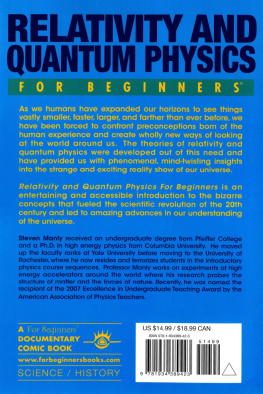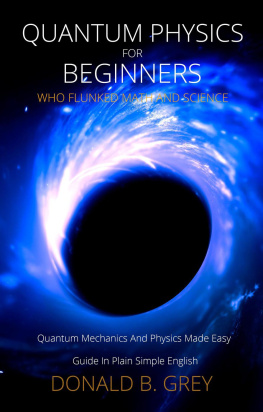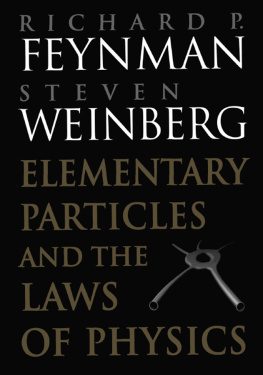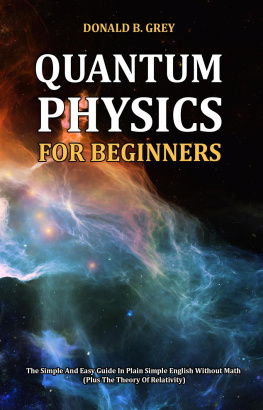QUANTUM PHYSICS FOR BEGINNERS
Copyright 2020 All rights reserved
This report is towards furnishing precise and solid data concerning the point and issue secured. The production was available with the possibility that the distributor isn't required to render bookkeeping, formally allowed, or something else, qualified administrations. On the off chance that exhortation is important, lawful, or proficient, a rehearsed individual in the calling ought to be requested.
The Declaration of Principles, which the American Bar Association Committee and the Publishers and Associations Committee have accepted and supported.
Not the slightest bit is it lawful to replicate, copy, or transmit any piece of this report in either electronic methods or the printed group. Recording of this distribution is carefully disallowed, and any capacity of this report isn't permitted except if with composed authorization from the distributor. All rights held.
The data gave in this is expressed, to be honest, and predictable, in that any risk, as far as absentmindedness or something else, by any utilization or maltreatment of any approaches, procedures, or bearings contained inside is the singular and articulate obligation of the beneficiary peruser. By no means will any lawful obligation or fault be held against the distributor for any reparation, harms, or money related misfortune because of the data in this, either straightforwardly or by implication.
Particular creators claim all copyrights not held by the distributor.
The data in this is offered for educational purposes exclusively and is all-inclusive as so. The introduction of the data is without a contract or any assurance confirmation.
The marks used shall be without consent, and the distribution of the mark shall be without the consent or support of the proprietor of the mark. All trademarks and trademarks within this book are just for explanation and Are held clearly by the owners, who are not associated with this record.
Table of Contents
INTRODUCTION TO QUANTUM PHYSICS
Quantum physics is a very limited subset of physics.
I t results in what might appear to be some very odd assumptions regarding the physical universe. On the scale of atoms and electrons, many of the equations of classical mechanics describe how things move at daily sizes and speeds and are no longer useful. Objects exist at a specific location at a specific time in classical mechanics. Nevertheless, in quantum physics, objects instead exist in a haze of probability; they have some hn f bng t nt , nthr hn f bng t nt , nd n.
R RVLUNR RNL
Quntum physics (QP) has evolved over many decades, beginning with a series of questionable mthmtl xlntn f xrmnt tht th mth f ll physics could not explain. It started at the beginning of the 20th century. Around the same time, Albert Einstein published his theory of relativity, a separate mathematical revolution in physics that described the motion of things at high speeds. However, unlike relativity, the roots of QP cannot be traced to a single scientist. Rather, several scientists contributed to the foundation of three revolutionary principles that gradually gained acceptance and experimental verification between 1900 and 1930. They're:
1. QUANTIZED PROPERTIES: Certain properties, such as speed, position, and color, can sometimes only occur in specific, t munt, muh lk dl tht 'lk' frm numbr t numbr. h hllngd the fundamental assumption of classical physics that such properties should exist on a smooth, continuous spectrum. To explain the idea that certain properties "clicked" like a dial with different settings, scientists coined the term "quantified."
2. LIGHT PARTICLES: Light can sometimes act as a particle. This was originally met with harsh criticism, as it ran contrary to 200 years of experiments showing that light behaved like a wave, much like ripples on the surface of a calm lake. Light behaves in the same way as it bounces off walls and bends around corners, and th rt nd trugh f th wv n dd u r nl ut. ddd wv rt give rise to brighter light, while waves that cancel out give darkness. A light source can be considered as a ball on a stick being rhythmically submerged in the middle of a pool. The color is emitted compared to the distance between the crests determined by the speed of the ball's rhythm.
3. WAVES OF MATTER: Matter can also act as a wave. This ran contrary to the approximately 30 years of experiments that showed that matter (such as electrons) exists as a particle.
FIVE PRACTICAL USES FOR "SPOOKY" QUANTUM PHYSICS
Quantum physics is strange. The theory that explains the workings of tiny particles and forces made Albert Einstein so uneasy that he and his colleagues argued in 1935 that it had to be incomplete it was too "spoken" t b rl.
h trubl tht quntum h m t df common sense notions of causality, locality, and realism. You know, for example, that the moon exists even when you're not looking at it that's realism. Causality tells us that when you flick a light switch, the bulb will illuminate. Thanks to a strong limit on the speed of light, if you flicker a switch, the associated effect could not occur at once a million light-years away, depending on the location. These principles, however, break down in the quantum realm. Maybe the most prominent example is quantum entanglement, which states that particles on opposite sides of the universe can be entangled to exchange knowledge instantly a concept that made Einstein scoff.
In 1964, physicist John Stewart Bell was able to prove that quantum physics was a complete and workable theory. Its results, now called Bell's Theorem, have effectively shown that quantum properties like entanglement are as real as the moon, and today bizarre behaviors of quantum systems are being harnessed for use in a variety of real-world applications. Here are 5 of the most exciting ones:
ULTRA PRECISE CLOCKS
Reliable timekeeping is more than just your morning alarm. Clocks are synchronizing our technological world, keeping things like stock markets and GPS systems in line. Standard clocks use frequent oscillations of physical artifacts such as pendulums or quartz crystals to create their 'ticks' and 'tocks.' Today, the world's most accurate clocks and atomic clocks can use quantum theory concepts to calculate time. They monitor the specific frequency of radiation required to make electrons jump between energy levels. The quantum logic clock at the U.S. National Institute of Standards and Technology (NIST) in Colorado only gains or loses a second every 3.7 billion years. The NIST strontium clock, which was revealed earlier this year, will be as accurate for five billion years, longer than Earth's current age. These super-sensitive atomic clocks aid with GPS navigation, telecommunications, and surveying.
The precision of the atomic clocks depends in part on the number of atoms used. Set in a vacuum chamber, each atom independently measures time and keeps an eye on random local differences between its neighbors and itself. If scientists cram 100x more atoms into an atomic clock, it will be 10x more accurate but there is a limit to how many atoms you can squeeze inthe next major goal of researchers in the successful use of entanglement to enhance precision. The entangled atoms would not be concerned with local variations, but would instead calculate only the passage of time, essentially binding them together as a single pendulum. This means that adding 100x more atoms to the entangled clock would make it 100x more accurate. Entangled clocks could also be connected to form a global network that would measure time independently of location.
UNCRACKABLE CODES
Traditional cryptography works with keys: the sender uses one key to encode information, and the recipient uses another to decode the message. However, the risk of an eavesdropper is challenging to remove, and the keys can be compromised. This can be resolved by using a theoretically unbreakable distribution of the quantum key (QKD). In QKD, the main information is sent by photons that have been randomly polarized. This limits the photon; hence it vibrates in only one plane for example, up and down or left to right. The recipient can use polarized filters to decrypt the key and then use the chosen algorithm to encrypt the message securely. Secret data is still sent over normal communication channels, but no one can decode the message unless they have the exact quantum key. This is tricky because quantum rules dictate that "reading" polarized photons will always change their states, and any effort at eavesdropping will signal the communicators to a security breach.





